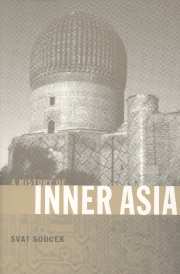Book contents
- Frontmatter
- Contents
- List of maps
- Preface
- Introduction
- 1 The beginnings
- 2 The Kök Turks, the Chinese expansion, and the Arab conquest
- 3 The Samanids
- 4 The Uighur kingdom of Qocho
- 5 The Qarakhanids
- 6 Seljukids and Ghaznavids
- 7 The conquering Mongols
- 8 The Chaghatayids
- 9 Timur and the Timurids
- 10 The last Timurids and the first Uzbeks
- 11 The Shaybanids
- 12 The rise of Russia, the fall of the Golden Horde, and the resilient Chaghatayids
- 13 The Buddhist Mongols
- 14 Bukhara, Khiva, and Khoqand in the seventeenth to nineteenth centuries
- 15 The Russian conquest and rule of Central Asia
- 16 From Governorates-General to Union Republics
- 17 Soviet Central Asia
- 18 Central Asia becomes independent
- 19 Sinkiang as part of China
- 20 Independent Central Asian Republics
- 21 The Republic of Mongolia
- Summary and conclusion
- Appendix 1 Dynastic tables
- Appendix 2 Country data
- Select bibliography
- Index
12 - The rise of Russia, the fall of the Golden Horde, and the resilient Chaghatayids
Published online by Cambridge University Press: 05 June 2012
- Frontmatter
- Contents
- List of maps
- Preface
- Introduction
- 1 The beginnings
- 2 The Kök Turks, the Chinese expansion, and the Arab conquest
- 3 The Samanids
- 4 The Uighur kingdom of Qocho
- 5 The Qarakhanids
- 6 Seljukids and Ghaznavids
- 7 The conquering Mongols
- 8 The Chaghatayids
- 9 Timur and the Timurids
- 10 The last Timurids and the first Uzbeks
- 11 The Shaybanids
- 12 The rise of Russia, the fall of the Golden Horde, and the resilient Chaghatayids
- 13 The Buddhist Mongols
- 14 Bukhara, Khiva, and Khoqand in the seventeenth to nineteenth centuries
- 15 The Russian conquest and rule of Central Asia
- 16 From Governorates-General to Union Republics
- 17 Soviet Central Asia
- 18 Central Asia becomes independent
- 19 Sinkiang as part of China
- 20 Independent Central Asian Republics
- 21 The Republic of Mongolia
- Summary and conclusion
- Appendix 1 Dynastic tables
- Appendix 2 Country data
- Select bibliography
- Index
Summary
The rule of Husayn Bayqara (1469–1506) coincided for the most part with that of Ivan III (1462–1505), the knyaz or prince of Moscow (or Muscovy, to use the contemporary English name of the principality). If the Timurid's reign shone with the sophistication of cultural life in Herat, the Muscovite's stood out for different reasons: definitive emancipation from the “Tatar yoke” in 1480, and rapid unification of other principalities under that of Moscow. By the time Ivan III's grandson, Ivan IV “the Terrible” (1530–84), ascended the throne in 1547, Muscovy had become Russia, a nascent empire ruled by an ever more powerful tsar.
The rise of a unified Russia was mirrored, in reverse fashion, by the decline of her erstwhile Mongol suzerain. The Khanate of Kipchak, the “Golden Horde” of the Russians, had already been dealt a heavy blow when Timur devastated its capital city Saray and other economic centers in 1395, and it was in due course rent asunder by mutual rivalries that by 1466 produced four separate khanates: the “Great Horde,” a paltry remnant of the once mighty khanate, located to the west of the lower Volga; and the Khanates of Kazan, Astrakhan and the Crimea. In 1502 the ruler of the last-named khanate, Mengli Girey, did Russia's work at her adversary's expense, for he destroyed what was left of the “Great Horde,” thus removing the one unit that might have attempted a reconstitution of the Golden Horde.
- Type
- Chapter
- Information
- A History of Inner Asia , pp. 162 - 166Publisher: Cambridge University PressPrint publication year: 2000



